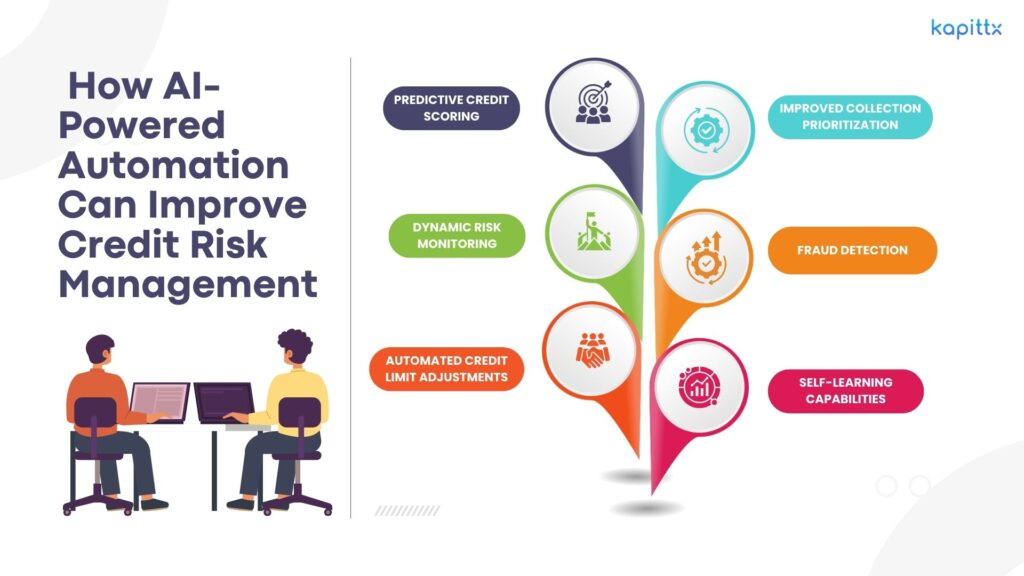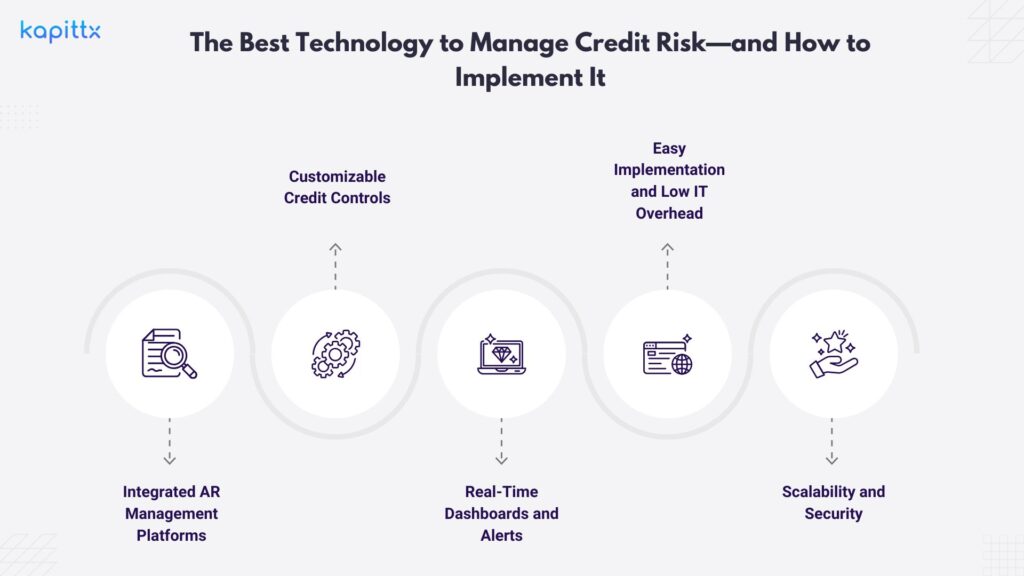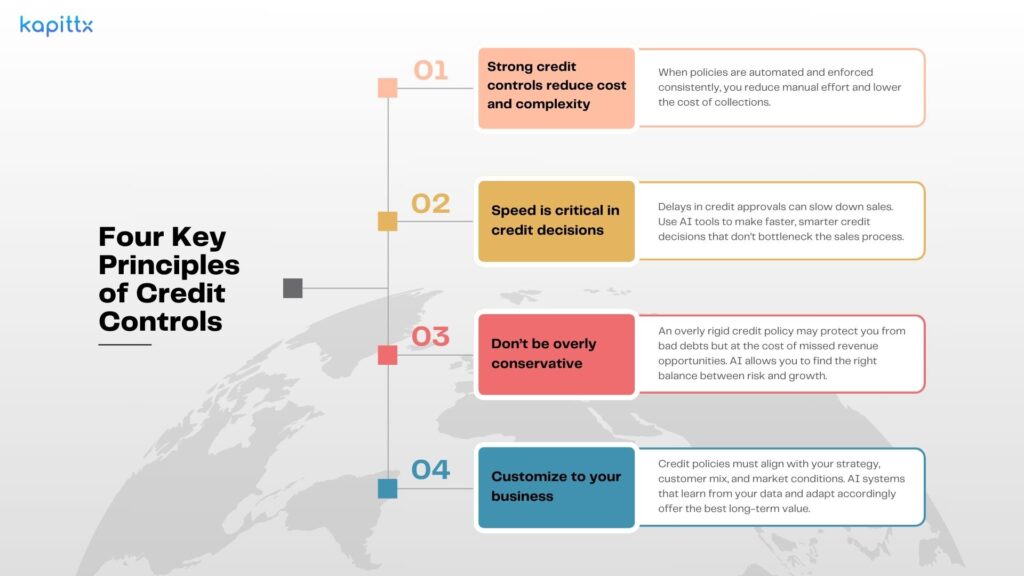Transforming Accounts Receivable with AI: A New Era of Efficiency
March 4, 2025Managing credit risk is a critical part of financial operations for any business that sells on credit. In a world where timely payments impact everything from cash flow to growth planning, managing risk intelligently and proactively is no longer optional—it’s essential. With the rise of artificial intelligence (AI) and automation tools, companies now have a powerful way to take credit risk management to the next level.
In this blog, we’ll explore what credit risk management is, the types of credit risk businesses face, the best practices for managing it, and how AI-driven automation tools like Kapittx can transform your approach to managing and mitigating risk.
What is Credit Risk Management?
Credit risk management refers to the process of identifying, assessing, and mitigating the risk that a customer will fail to pay for goods or services sold on credit. This risk is inherent in any business-to-business (B2B) transaction where payment is deferred, and managing it well is key to preserving cash flow and reducing financial exposure.
Credit risk doesn’t just affect your bottom line—it can disrupt your entire working capital cycle. Companies with poor credit controls often find themselves chasing payments, writing off bad debts, or limiting their ability to grow due to cash shortages. On the other hand, well-managed credit policies allow businesses to expand safely and maintain strong financial health.
Types of Credit Risk
Credit risk has two primary dimensions:
a. Bad Debt Risk (Non-Payment)
This is the most severe form of credit risk—when a customer fails to pay the invoice entirely. Whether due to insolvency, disputes, or poor internal processes, this type of loss can directly impact profitability.
b. Delinquency Risk (Late Payment)
Not all credit risk comes from outright defaults. Many businesses suffer from delayed payments, which increase collection costs, disrupt forecasting, and strain cash flow. Delinquency can also be a leading indicator of future defaults, making early detection crucial.
Understanding both dimensions is key to building a robust credit risk management framework that doesn’t just react to problems, but anticipates them.
Best Practices to Manage Credit Risk
Managing credit risk effectively requires a combination of policy, process, and technology. Here are some best practices that every finance team should consider:

a. Set Clear Credit Policies
Establish clear rules for granting credit, including criteria based on customer size, industry, payment history, and financial health. These policies should be tailored to your company’s risk appetite and customer base.
b. Automate Credit Checks
Integrate credit bureau data or third-party financial analysis tools to run instant credit checks during customer onboarding. This helps reduce manual errors and ensures consistency in decision-making.
c. Segment Customers by Risk Level
Not all customers carry the same risk. Segmenting customers based on payment behavior, industry trends, and credit ratings allows for more targeted credit limits and collection strategies.
d. Monitor Continuously
Credit risk is not static. Regularly review customer performance and adjust credit limits accordingly. Watch for warning signs such as consistent late payments or increasing disputes.
e. Strengthen Collection Processes
A strong accounts receivable team with timely follow-ups, automated reminders, and flexible payment plans can reduce delinquency and improve cash recovery.
How AI-Powered Automation Can Improve Credit Risk Management
Artificial Intelligence (AI) is reshaping how companies manage credit risk by making processes smarter, faster, and more predictive. Here’s how AI can help:

a. Predictive Credit Scoring
AI models can analyze vast amounts of data—both internal (like past payment history) and external (like market conditions or credit bureau data)—to generate real-time credit scores. These predictive scores allow companies to make better credit decisions upfront.
b. Dynamic Risk Monitoring
Instead of relying on periodic reviews, AI systems can continuously track customer behavior and financial signals. For example, if a customer who used to pay on time begins delaying payments, AI can trigger alerts before the risk escalates into a default.
c. Automated Credit Limit Adjustments
Based on changing risk profiles, AI can suggest or automatically adjust credit limits, reducing exposure without needing manual intervention. This real-time responsiveness is crucial in fast-moving markets.
d. Improved Collection Prioritization
AI can rank outstanding invoices based on the likelihood of collection, helping teams prioritize efforts on high-risk accounts. This improves the efficiency of collections and reduces overall Days Sales Outstanding (DSO).
e. Fraud Detection
By analyzing behavioral patterns and historical data, AI can flag unusual activities that might indicate fraud or intentional delays—providing another layer of protection.
f. Self-Learning Capabilities
AI models learn and improve over time. As more data flows through the system, AI can fine-tune predictions and recommendations, creating a self-improving risk management loop.
The Best Technology to Manage Credit Risk—and How to Implement It
Choosing the right technology stack is critical to achieving AI-powered credit risk management. Here’s what to look for and how to implement it:

a. Integrated AR Management Platforms
Platforms like Kapittx offer end-to-end accounts receivable automation with built-in AI credit risk tools. These platforms integrate with ERPs like SAP, Oracle, and Tally to pull financial data directly and provide actionable insights without data silos.
b. Customizable Credit Controls
Every business is unique. The best tools allow you to customize risk models, approval workflows, and credit policies based on your specific industry, customer profile, and tolerance for risk.
c. Real-Time Dashboards and Alerts
A good system should offer intuitive dashboards that show overall credit exposure, aging reports, and risk alerts in real time. This enables finance teams to take proactive actions rather than reactive ones.
d. Easy Implementation and Low IT Overhead
Look for cloud-native solutions that can be implemented with minimal disruption to your existing tech stack. Platforms with API-based integration and pre-built connectors for major ERPs ensure smooth onboarding.
e. Scalability and Security
Ensure the platform supports your growth, both in terms of volume and complexity. At the same time, check for compliance with data security standards like GDPR, SOC 2, and ISO 27001.
Four Key Principles of Credit Controls
As you rethink your credit risk strategy, keep these four principles in mind:

- Strong credit controls reduce cost and complexity
When policies are automated and enforced consistently, you reduce manual effort and lower the cost of collections. - Speed is critical in credit decisions
Delays in credit approvals can slow down sales. Use AI tools to make faster, smarter credit decisions that don’t bottleneck the sales process. - Don’t be overly conservative
An overly rigid credit policy may protect you from bad debts but at the cost of missed revenue opportunities. AI allows you to find the right balance between risk and growth. - Customize to your business
Credit policies must align with your strategy, customer mix, and market conditions. AI systems that learn from your data and adapt accordingly offer the best long-term value.
Conclusion: Smarter Credit Risk, Smarter Growth
AI is no longer a futuristic add-on—it’s a practical tool for modern finance teams looking to optimize credit risk management. With AI-powered platforms like Kapittx, you can gain visibility into customer behavior, reduce bad debt and delinquency, and improve working capital—all while enabling growth.
The real advantage of AI lies not just in automation but in intelligent automation. By using machine learning to continuously improve decision-making, businesses can build a resilient, responsive, and profitable credit management system.
In today’s economic climate, managing credit risk isn’t just about protecting your business—it’s about empowering it. And with AI, that’s finally within reach.
FAQ
What is credit risk management?
Credit risk management is a fundamental financial strategy that ensures businesses can extend credit to customers while minimizing potential losses due to non-payment. It involves identifying, assessing, and mitigating the likelihood that a customer or business partner will fail to meet their financial obligations.
How AI Can Improve Credit Risk Management?
Artificial Intelligence (AI) is transforming credit risk management, enabling businesses to make smarter, faster, and more accurate decisions.
1. Predictive Credit Risk Analytics
AI leverages historical data and market trends to predict customer payment behavior and potential defaults. By identifying early warning signals, businesses can proactively adjust credit limits or take preventive action before a risk materializes.
2. Automated Credit Scoring & Decision Making
Traditional credit assessments rely on manual evaluations, which can be slow and inconsistent. AI-powered models analyze vast amounts of financial data in real-time, ensuring accurate credit scoring and automated decision-making. This improves efficiency while reducing human bias.
3. Real-Time Risk Monitoring
AI continuously monitors customer transactions, payment patterns, and economic conditions to detect evolving credit risks. Kapittx provides dynamic risk alerts, allowing businesses to respond quickly to financial red flags and prevent bad debt accumulation.
4. Fraud Detection & Prevention
AI-driven anomaly detection helps businesses identify fraudulent activities within credit transactions. Machine learning algorithms pinpoint suspicious patterns, ensuring credit is extended to genuine, trustworthy customers while minimizing financial losses.
5. Optimized Collections & Recovery Strategies
AI enhances collections management by analyzing payment behaviors and suggesting the best recovery approaches. Businesses can automate personalized reminders, optimize follow-up timelines, and improve the likelihood of successful debt recovery.
6. Enhanced Liquidity & Cash Flow Forecasting
With AI-powered insights, businesses can anticipate cash flow fluctuations and optimize liquidity. Kapittx enables companies to make data-driven decisions on credit policies, ensuring financial stability.
7. Intelligent Dispute Resolution
AI simplifies credit dispute handling by analyzing patterns in past resolutions, reducing manual intervention, and ensuring faster settlements. This strengthens customer relationships while safeguarding receivables.
With Kapittx’s AI-driven credit risk management solutions, businesses can minimize financial uncertainty, boost profitability, and enhance operational efficiency—paving the way for sustainable growth.
What are the 3 types of credit risk?
Credit risk is a critical factor in managing receivables and ensuring financial stability for businesses. Here are the three primary types of credit risk that businesses should be aware of:
1. Default Risk
This is the most common type of credit risk, where a customer or debtor fails to meet payment obligations on time or entirely defaults. In B2B transactions, delayed or missed payments can significantly impact cash flow, operational efficiency, and profitability. Kapittx helps businesses mitigate default risk by providing real-time credit insights, automated payment tracking, and early warning signals on high-risk accounts.
2. Concentration Risk
When a business relies heavily on a few key customers for revenue, it faces concentration risk. If one or more major clients experience financial distress or fail to make payments, it can threaten the company’s overall financial health. Kapittx enables businesses to diversify their receivables portfolio by offering analytics on customer creditworthiness, helping companies expand into lower-risk markets and manage credit exposure effectively.
3. Liquidity Risk
Liquidity risk arises when businesses struggle to convert their receivables into cash quickly enough to meet their financial obligations. Even if customers eventually pay, delays in collection can create operational challenges. Kapittx addresses liquidity risk by automating receivables management, optimizing collection strategies, and ensuring businesses maintain a steady cash flow without unnecessary bottlenecks.
With Kapittx’s intelligent credit management solutions, businesses can proactively mitigate these risks, strengthen financial resilience, and optimize their working capital strategy.
What are the five pillars of credit risk?
The Five Pillars of Credit Risk
Effective credit risk management is essential for businesses to protect their revenue, optimize cash flow, and maintain financial stability. At Kapittx, we focus on five key pillars that help organizations mitigate credit exposure and make informed decisions.
1. Creditworthiness Assessment
Before extending credit, businesses must evaluate a customer’s ability to repay. This includes analyzing financial statements, credit history, payment behavior, and industry standing. Kapittx enables companies to streamline this process with real-time data insights and credit scoring models.
2. Credit Limits & Exposure Management
Setting appropriate credit limits is crucial to prevent excessive exposure to risky customers. Kapittx helps businesses define dynamic credit limits based on customer behavior, past transactions, and risk profiles, ensuring a balanced credit portfolio.
3. Continuous Monitoring & Early Warning Systems
Credit risk is not static—it evolves with market changes and customer financial conditions. Our platform provides automated monitoring with alerts on delayed payments, financial distress signals, and potential defaults, allowing businesses to act proactively.
4. Collections & Dispute Resolution
A structured collections strategy helps reduce overdue payments and disputes. Kapittx automates follow-ups, sends reminders, and provides insights on resolution timelines to improve recovery rates while maintaining customer relationships.
5. Liquidity & Cash Flow Optimization
A business’s ability to maintain liquidity depends on efficient accounts receivable management. Kapittx ensures companies convert outstanding invoices into cash faster, reducing financial strain and enabling smoother operations.
With these five pillars, Kapittx empowers businesses to strengthen financial resilience, reduce credit risk, and drive sustainable growth.
What are the benefits of credit risk management?
The Benefits of Credit Risk Management
Effective credit risk management is essential for businesses to safeguard their financial health and ensure stability in their receivables. At Kapittx, we empower companies to proactively manage credit risks, reducing financial exposure while optimizing growth opportunities. Here are the key benefits:
1. Improved Cash Flow & Liquidity
By minimizing the risk of payment delays and defaults, businesses can maintain a steady cash flow. Kapittx automates payment tracking and collections, ensuring invoices are processed efficiently to enhance liquidity.
2. Reduced Bad Debts & Financial Losses
Poor credit decisions can lead to bad debts, impacting profitability. Kapittx helps companies evaluate customer creditworthiness, set appropriate credit limits, and prevent excessive exposure, reducing write-offs.
3. Stronger Customer Relationships
A well-structured credit management system promotes transparent credit policies and timely communication with customers. This fosters trust, enhances customer relationships, and ensures smoother transactions.
4. Increased Business Growth & Profitability
With optimized credit risk strategies, businesses can safely extend credit to reliable customers while avoiding unnecessary risks. This enables sustainable expansion, higher revenues, and stronger financial performance.
5. Early Warning System for Credit Risks
Kapittx provides real-time monitoring and analytics, identifying potential risks before they become financial burdens. Businesses can act proactively, mitigating threats and securing their financial future.
6. Compliance & Regulatory Assurance
Managing credit risk effectively ensures businesses adhere to industry regulations and financial best practices. Kapittx supports compliance by providing accurate credit assessments and audit-ready documentation.
7. Optimized Accounts Receivable Management
A well-structured credit risk framework ensures efficient invoicing, payment follow-ups, and dispute resolution, preventing bottlenecks in the receivables cycle.
By leveraging Kapittx’s intelligent credit risk management solutions, businesses can reduce financial uncertainty, strengthen operational stability, and unlock new growth opportunities.
What are the key components of credit risk management?
Key Components of Credit Risk Management
Customer Creditworthiness Assessment Before extending credit, businesses must evaluate a customer’s financial health. This includes reviewing their credit history, financial statements, payment behavior, and industry standing. Many companies rely on credit scoring models or third-party credit rating agencies for additional insights.
Credit Limits and Terms Setting appropriate credit limits and payment terms ensures businesses do not expose themselves to excessive risk. Companies may establish customized credit policies based on customer profiles and transaction values.
Monitoring and Reporting Continuous monitoring of outstanding invoices, payment trends, and industry risks is crucial. Automated reporting tools help identify early warning signs of potential defaults, allowing businesses to take proactive measures.
Mitigation Strategies Businesses can minimize exposure through diversification, trade credit insurance, contractual guarantees, and securitization techniques. Additionally, structuring invoices with periodic due dates reduces the likelihood of accumulating large unpaid balances.
Collections and Dispute Resolution An efficient collections strategy ensures that overdue payments are recovered promptly. Businesses should maintain clear communication channels with customers to address payment disputes and resolve outstanding balances amicably.
